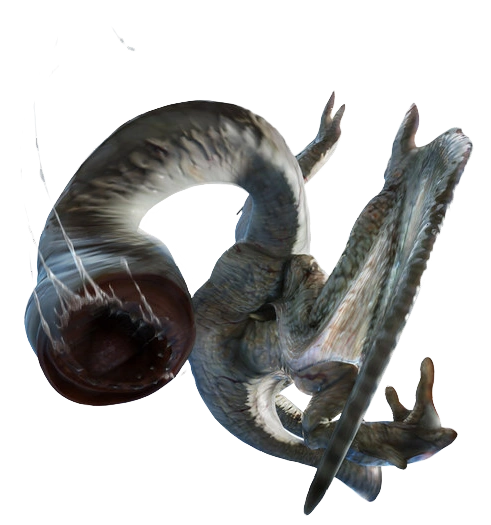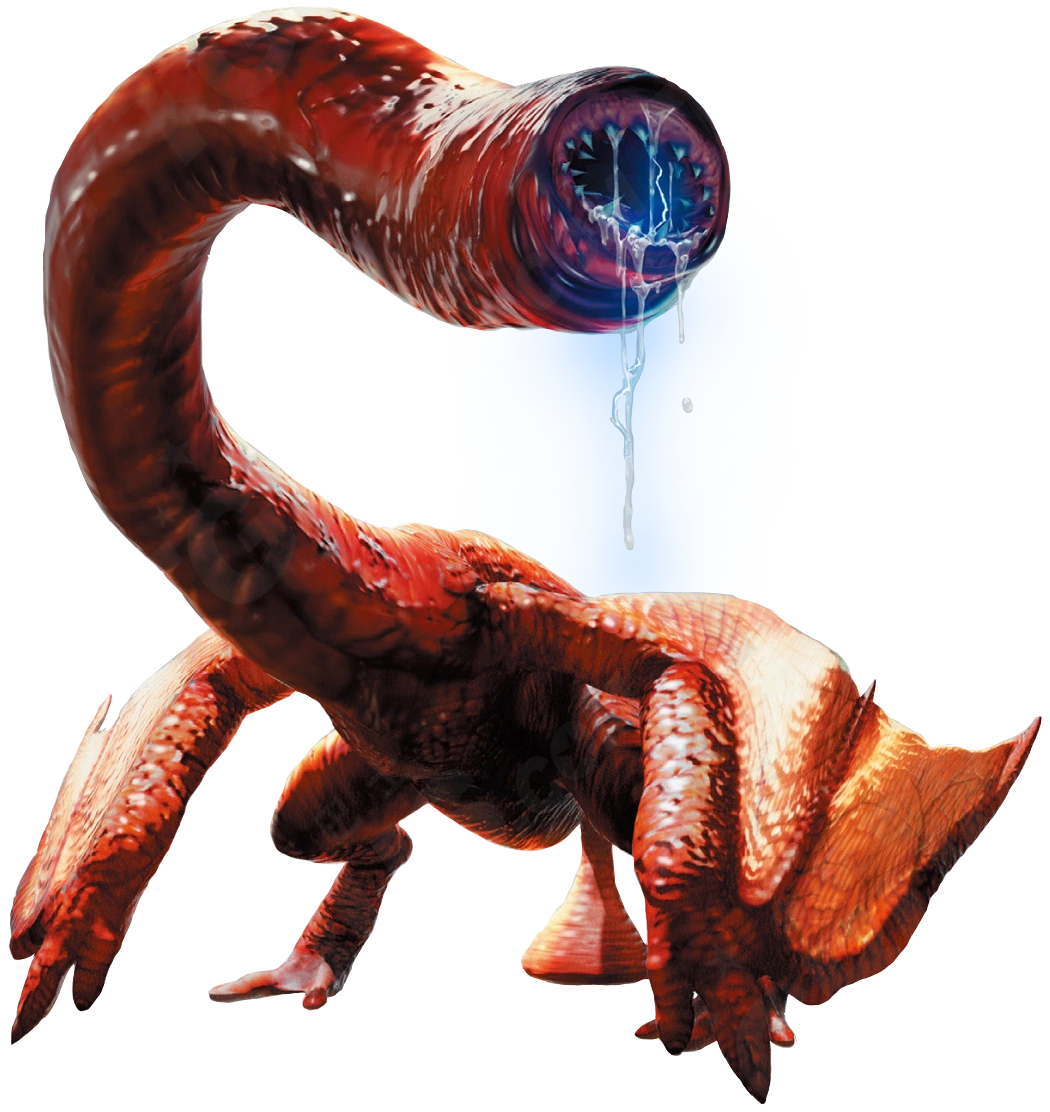Khezu are well-known for their electrical abilities. They are able to emit electricity from its entire body, and will couple this ability together with their pouncing and charging attacks when enraged. As a ranged attack that paralyzes prey, they can launch lightning balls from their mouths as well. Three smaller lightning balls can be released simultaneously which spread out in front of the monster by moving across cave floors or even along cave walls. Alternatively, from a hanging position on walls or ceilings the Khezu can hurl or drop a single larger lightning ball. If they are stationary while performing an electrical attack, they will ground themselves using the suction cup on their tails [to release excess electricity, as they do not have specialized structures like spines or fur for storing it]. *The large amount of fat in their body may also insulate and protect them from their own electric shocks.*
Seemingly able to inhabit any sufficiently large cave system, Khezu are found in a wide variety of different locales including polar environments, snowy mountains, temperate swamps and tropical jungles. Some reports indicate that Khezu found in colder areas will migrate to warmer areas during winter. Besides that, it is said that Khezu prefer inhabiting areas close to active sources of water, perhaps to help conducting electricity into prey or to ensure that their skin remains moist. In snowy areas, their white hide actually camouflages them when they venture out of caves for whatever reason.
As prey is scarce in caves, Khezu likely feed on anything they can catch and kill, and the large amount of fat stored in their body may help them survive for longer periods of time between feeding. With low visibility in the caves, Khezu are at a major advantage with their excellent senses of smell and hearing. *Experiments conducted on captive Khezu suggest that they are able to detect live prey through electrolocation or some other ability without using their senses of smell and hearing, but no concrete conclusions have been made.* Normally, they feed on Herbivores that may enter caves for shelter such as Kelbi, Aptonoth and Popo. They could potentially easily prey on small Bird Wyverns [and Ceanataurs too, especially given the latter's weakness to electrical attacks.] Although they prefer feeding on live prey, they will scavenge carcasses as well. The saliva of a Khezu is highly acidic helping it to completely digest its prey. When hunting larger or more dangerous prey, they will opt to incapacitate them with their electrical attacks before pouncing on them. For smaller prey, they usually remain motionless while extending their neck to catch prey and swallow them whole. However, the Khezu's neck will lose its elasticity and start to droop with age, resulting in the monster being unable to feed and eventually dying from starvation.
In combat, Khezu are not particularly mobile, but are capable of bursts of speed when pouncing on prey. This may stem from their fat bulky bodies and/or from the fact that they rely heavily on their sense of smell to locate enemies, which is slower than using sight or hearing. Aside from the techniques they typically use in capturing prey, they will use their tails as whips while fighting like many other wyverns. They are also known for their nightmarish roar, which they often use repeatedly in battle. [It's possible that they use the reverberations of their cave habitats to amplify the roars to further terrify and stun opponents.] While most creatures would not normally hunt Khezu due to its potent electrical abilities, the Shrouded Nerscylla hunts Khezu and wears its hide on its body. It is speculated that they hunt Khezu as their hides help them to retain moisture in their desert habitats.
Another unusual aspect of the Khezu is their reproductive biology. Since a single cave system may only be able to support one Khezu, it is rare for Khezu to encounter another one of its own kind. As a result, they have evolved to become hermaphrodites capable of reproducing without the need of a mate. When they breed, they will paralyze a medium-sized Herbivore like Aptonoth or Popo to use as a host. The eggs that are then deposited on the paralyzed monster will hatch into whelps that will feed internally on the host as endoparasites. After reaching a certain size, the whelps will emerge from the host and conceal themselves in places like tight crevices to ambush their next victim. At this stage of their life cycle, they behave as ectoparasites instead. It is also interesting to note that the orifice at the end of a Khezu's tail functions as a mouth for whelps to feed on blood.
The closest relatives of the Khezu are the Gigginox, which share a similar lifestyle.
Red Khezu are an uncommon or rare Subspecies of Khezu with a blood-red hide. Its is said that Red Khezu are normal individuals, while "regular" Khezu are actually albinos. Despite that, the red coloration makes them stand out more than standard Khezu, which decreases their chances of survival. [Since they still dwell in caves most of the time like standard Khezu, this is not as much of a detriment to them as it is to Subspecies like Azure Rathalos and Pink Rathian, which are extremely rare as a consequence.] Regardless, the Red Khezu that have survived to adulthood are more powerful than regular Khezu, possessing more muscle mass and improved control over their electrical abilities and neck-thrusting attacks. The elemental weaknesses of their hide differ from their regular counterparts as well. While they are found in the same environments as regular individuals, it is reported that they can overwinter even in colder areas due to their increased body mass.

No comments:
Post a Comment